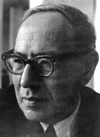
Cyril Pavlovich Florensky, prominent Soviet (Russian) planetologist, started his scientific career as a laboratory assistant for outstanding Russian scientist Vladimir I. Vernadsky at the Biogeochemical Laboratory of Academy of Sciences of USSR in Moscow in 1935. He assisted Vernadsky in that time pioneering the study of isotopic composition of natural waters and in biogeochemical experiments. It was good school for young scientist. Unfortunately it was interrupted by World War II. In 1941-42 he worked in the Commission of Geologic-Geographic Service for the Soviet Army. Since fall of 1942 he served in Soviet Army in the artillery reconnaissance unit and had passed difficult way from Stalingrad to Berlin.
In
1946 Cyril Pavlovich returned to the Biogeochemical Laboratory, which since 1947
became to be Institute of Geochemistry and Analytical Chemistry named after V.
I. Vernadsky. He studied mostly geochemistry of volcanic and other natural
gases.
In
the middle 1950s, beginning 1960s, Florensky organized several expeditions to the
area of Tunguska catastrophe in Siberia. The expeditions documented pattern of
the forest fall around epicenter of the explosion, confirmed observations of the first Tunguska expeditions organized in 1920s by L. A.
Kulik, and
collected samples of soils and pits containing in which admixture of cosmic
spherules was found. Profound analysis of the collected samples and as well as
physics of hypervelocity impacts led him in 1965 to publication of the concept
of chemical differentiation of the protoplanetary matter in a process of its
accretion into a planet. Early formation in this process of atmosphere and
hydrosphere was suggested, the revolutionary idea for that time.
Meantime,
the cosmic era began. C. P. Florensky was heavily involved in design of
sensors for gas composition analysis, which were flown on board of Soviet Venera
4 and determined chemical composition of atmosphere of Venus. In 1967 he was
sent to the newly organized Institute for Space Research of the Soviet Academy of
Science, where he organized the Laboratory of Comparative Planetology. This
laboratory first did a selection and characterization of landing sites for
(never flown) Soviet manned expedition to the Moon. Soon after, similar work was
done for Soviet robotic missions to the Moon: sample return by Luna 16, 20, 24
and rover-based studies by Lunokhod 1 and 2. After first robotic sample return
from the Moon in 1970, C. P. Florensky with a few colleagues spent most of his
time at Vernadsky Institute working on analysis of lunar samples.
In
1975 the Laboratory of Comparative Planetology was moved to Vernadsky Institute.
Under the leadership of C. P. Florensky, the laboratory was involved in studies
of lunar samples and meteorite materials, photogeologic analysis of images of
surfaces of Mars and Venus taken by Mars 4,5 and Venera 9, 10, 13 and 14,
studies of terrestrial impact craters, experimental studies of chemical
differentiation in a process of impact induced vaporization of planetary
materials, and physicochemical computer modelling of processes of magmatic
differentiation. These complex studies eventually resulted in writing the book
“Etudes on Comparative Planetology” published in Russian in 1981 by Nauka
Press, Moscow. This was book written by several authors, members of the
Laboratory of Comparative Planetology, under intellectual leadership of C. P.
Florensky.
At
the last years of his life C. P. Florensky spent significant part of his time
preparing for publication several earlier unpublished works of V. I. Vernadsky:
The Chemical Structure of the Biosphere of the Earth and Its Surroundings,
Living Matter, and Reflections of a Naturalist. He also worked on a new
edition of Vernadsky’s Sketches of Geochemistry, his biographical works, and
letters as well. Short but profound in sense commentaries and forewords to these
editions, were always written by C. P. Florensky with maximum sincerity and
enormous respect for V. I. Vernadsky. Besides, C. P. Florensky took an active
part in a volunteer works on the protection and restoration of architectural
and historical monuments, prompting often simple, yet uniquely practical,
solutions.
He came forward with concrete suggestions in the area of environmental
protection
too.
Name
of Florensky was given to crater on the Moon (symbolically placed nearby crater
Vernadsky) and to a new meteoritical mineral (florenskyite, FeTiP).
Alexander T. Basilevsky